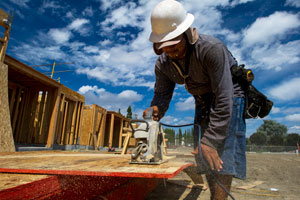Housing Starts Fall in Sign of Slow, Steady Recovery

New-home construction in the United States fell in August, indicating the real estate recovery will take time to evolve.
Residential starts declined 3% to a 1.13 million annualized rate from a 1.16 million pace the prior month that was slower than previously estimated, a Commerce Department report showed Sept. 17. The median forecast of 81 economists surveyed by Bloomberg News was 1.16 million.
Steady job gains and mortgage rates holding at historical lows are attracting more Americans to the real estate market even as wage growth remains tepid. Permits to build single-family houses climbed last month to the highest level in seven years, signaling builders remain confident even as the Federal Reserve is poised to raise interest rates this year.
“The housing recovery will continue to be bumpy, but we expect it to continue.” said Michelle Meyer, deputy head of U.S. economics at Bank of America Corp. in New York. “The labor market has improved, the economy has improved and we’re seeing pent-up demand for housing. So the backdrop is very supportive.”
Economist estimates in the Bloomberg survey ranged from 1.08 million to 1.25 million. The July figure previously was reported as a 1.21 million pace.
Permits, a proxy for future construction, climbed 3.5% to a 1.17 million annualized rate, indicating starts could edge up this month. They were projected to rise to a 1.16 million rate after 1.13 million the prior month, according to the survey median.
Applications to begin work on single-family houses, the largest and most economically significant part of the market, climbed to a 699,000 rate, the highest since January 2008.
Single-family starts fell 3% last month to a 739,000 rate from a seven-year high of 762,000 in July.
Work on multifamily homes, such as condominiums and apartment buildings, also declined 3% to an annual rate of 387,000. Data on these projects, which have led housing starts in recent years, tend to be volatile.
Three of four regions showed decreases in starts last month, led by a 33.7% slump in the Northeast, according to the report. The South showed the only advance.
Homebuilders have remained optimistic about the conditions and outlook in the residential real estate market. The National Association of Home Builders/Wells Fargo builder sentiment index rose to 62 this month, the highest level since October 2005, from 61 in August, the group’s report showed Sept. 16. Measures of buyer traffic and single-family sales both advanced, while a gauge of the outlook remained close to its highest in a decade.
Further momentum in the labor market is supporting consumers considering buying a home. Employers added 173,000 workers in August and the U.S. jobless rate dropped to 5.1%, the lowest since April 2008 and a level that the Federal Reserve considers to be full employment.
Another report Sept. 17 showed claims for jobless benefits declined last week to the lowest level in two months, highlighting the labor market’s resilience. Applications decreased by 11,000 to 264,000 in the period ended Sept. 12, according to figures from the Labor Department.
Borrowing costs also have remained a tailwind for would-be home buyers. The average 30-year fixed mortgage rate was 3.90% in the week ended Sept. 10, according to Freddie Mac data. That’s close to the 3.83% average so far this year, and compares with the 6.06% average in the five years leading to the last recession.
Fed policymakers meeting Sept. 16-17 in Washington are considering whether to raise the benchmark interest rate for the first time since 2006. Some policymakers have said turbulent financial markets and a weakening Chinese growth outlook muddy the argument for a rate hike this month, while others point to a strengthening labor market, which is one of the Fed’s mandates.

